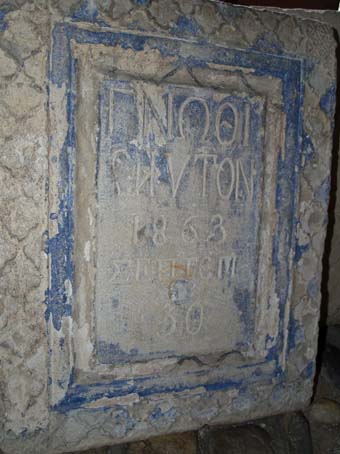In the veranda, near the entrance, there was a small exhibit of various artifacts, old farming implements as well as several stone fragments. One of them was this piece inscribed with Greek letters. I photographed it hoping that it was an example of Karamanlica, Turkish written with Greek characters. (If you go to this page and click on the second image, in the enlarged version you can see the subject stone on the right towards the back.)

Later, I transcribed the Greek letters into Turkish characters; but the words I got were meaningless. So, a couple of days ago, I e-mailed the picture to my friend Yorgi Sangiouloglou in Athens and asked for his help.
Yorgi informed me that it wasn't Karamanlica, but Greek and translated the phrase as the ancient dictum Gnothi eafton, "know yourself" (more info)
The date underneath is 1863 Septem[ber] 30.
Before the Greco-Turkish War (1919-1922), Safranbolu was home to many Greeks. Following the defeat of the Greek forces and the Treaty of Lausanne, the Anatolian Greeks were forced to migrate to Greece never to return. This stone is a fragment of the millennia old culture that disappeared with their departure.
Where did this inscription originally stand and what was the significance of the date on it? We will probably never know.
Source
No comments:
Post a Comment